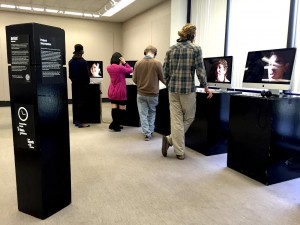When you think of war, what war comes to your mind?
How far removed are you from that war?
How has war impacted your work?
These simple questions are the substance of “18 Stories of War,” a film project with an international cast: members of the Center for Justice and Peacebuilding (CJP) community at Eastern Mennonite University (EMU) from current students and recent graduates to faculty, staff and family members.
Filmmakers Mikhala Lantz-Simmons and Mohammad Rasoulipour curated hours of interviews into short segments – the longest is seven minutes – that can be viewed in the Margaret Martin Gehman Gallery at the Hartzler Library through Jan. 28. [For library hours, click here.]
Everyone knows of war
In their selection of interviewees, the duo drew no limitations, as much interested in those who had been in the thick of battle – in Guatemala, Congo, Libya and Iraq, among other wars – as in those whose experience was limited to the shared memories of relatives. A Canadian-born man of Korean ancestry speaks of his father’s experiences in the Korean War. A Filipino woman remembers her grandfather fighting against the Japanese in World War II.
Each person’s reference point is important, the filmmakers say. War, unfortunately, is a part of human consciousness.

“Every single person we interviewed had a powerful connection to war, whether they were in a battlefield or not, whether that memory was constructed in their minds by their grandfather. That was crazy to me,” said Rasoulipour, a native of Iran who earned a graduate certificate in conflict transformation and currently interns with the Center for Interfaith Engagement at EMU.
Lantz-Simmons, a second-year CJP student, said the exploration comes an opportune time: “Stories are really powerful and in the current climate as people are talking about war without understanding what it entails and how lives are destroyed, it’s essential that we humanize these stories, that it’s not ‘boots on the ground,’ but people’s day-to-day experiences of holding their children, having your security ripped away from you.”
It’s important, too, that we listen and learn from the memories passed down through generations, she adds.
Choice of language accesses different war experience
Though the two filmmakers didn’t interview themselves – and in retrospect, they both wish they had joined their project as interviewees as a symbol of both solidarity and honesty – both also have personal perspectives on war.
Rasoulipour says that if he thinks about war in English, he immediately thinks of World War II, which he has studied with interest because of its long-term effects on his native country of Iran.
“But if I think of war in Farsi, I think of the Eight-Year War, which is also known as the Iran-Iraq War,” he says. Rasoulipour’s father was injured in a chemical weapons attack; one of his three uncles was killed.
Lantz-Simmons says her grandfather fought in Germany and France during World War II, and was among the first American soldiers to liberate the Dachau concentration camp; she only knows about this because her father pressed for this information for a college research paper that she ultimately read. “Otherwise, he never talked about it.”
A ‘healing element’

The project started with a conversation about war, in which the graduate students involved, all of whom were planning careers in some aspect of domestic or international peacebuilding and conflict resolution, arrived at a startling realization: they each had different perceptions and relationships to the experience and concept of war itself.
“While one person had experienced it firsthand, another person was four generations removed. We also noticed that we each cited different wars as reference points,” said Lantz-Simmons.
The duo, who were married this summer during the last stages of the project, were intrigued enough by the conversation and the questions it posed to apply for a CJP Arts and Peacebuilding grant.
Originally intended to include members of the Harrisonburg community, the project narrowed to CJP peacebuilders and their families when the filmmakers realized the depth of stories available.
In their first two interviews, with veterans Michael McAndrew (a CJP student) and Ryan Faraci (an EMU undergraduate), they came away with four hours of footage.
“We realized there was so much there and we needed to have more of a shape to what we were asking,” Lantz-Simmons said.
“There were times when I was trying to cut material, to edit, and I just couldn’t take out what they were saying,” Rasoulipour said. “I would have to ask Mikhala to come and do it for me.”
“We’d like to collect more,” Lantz-Simmons said. “There is a healing element to telling your story and we know there are so many more in our community with experiences of war. We had people who learned about the project who reached out to us, right around the time we were done, who wanted to tell their story.”
After the show closes, the two hope to find new exhibit space and to look for opportunities in local classrooms or among community organizations to talk about their work, facilitate discussions about war and to hear experiences of others in the Harrisonburg community.
